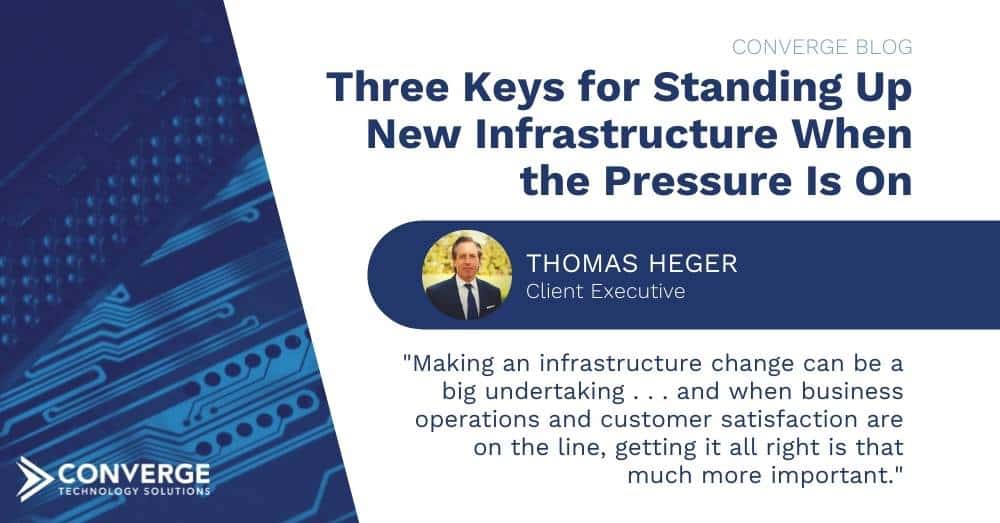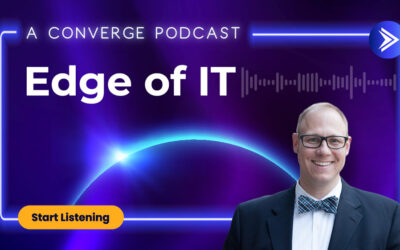As we all know, 2020 was a year of turbulence and change for many businesses, especially in industries such as retail. In particular, the COVID-19 pandemic put a lot of pressure on brands to offer new and different digital experiences at a time when demand for in-store shopping was falling and stay-at-home orders were in effect. In the last year, our team at Converge has helped clients pivot fast to stand up new tech and infrastructure to keep their business operations running and keep delivering value for their customers.
While the circumstances have at times been unprecedented, I found that three foundations remained constant in delivering a successful infrastructure initiative:
- Using analytics to model capacity needs upfront
- Understanding and adapting to logistics demands
- Relying on proven talent to speed up implementation
Each of these foundations came up big in one particular project that I’d like to share with you. Here, we helped a luxury fashion company scale their ecommerce capacity during the pandemic to meet a 4x jump in digital customer demand by standing up new infrastructure in time for their holiday sales surge. Let’s see how.
Planning a pandemic pivot to meet digital expectations
Like many retail brands, during the COVID-19 pandemic, our client—a global high-end fashion company—saw significant disruption to their business in 2020. As an owner of several iconic brands with a global retail footprint, our client was facing declining sales and store closures because of the pandemic. Early in 2020, they quickly shifted their focus to digital customer experiences and driving online sales through their ecommerce platform. For example, they started selling products from their outlet stores online, which had previously been sold only in stores.
As a result of these changes, customer demand for online purchases spiked. In May of 2020, the company was forecasting a 400% increase in ecommerce sales over the holiday season. However, the company was running their ecommerce platform on infrastructure that was a decade old, which wouldn’t be able to handle the increased workload to process the forecasted sales transactions without significant delays in order fulfillment. They needed an infrastructure reboot, and it had to happen fast.
Standing up new infrastructure at speed and scale
In May, our client reached out to us at Converge, as we’ve been their long-time partner. They wanted us to help them replace their outdated ecommerce infrastructure with a modern solution that could handle their growing business needs. Because the company needed to move fast and was already running IBM systems, it made the most sense to move forward with an on-premises hardware solution instead of moving to the cloud.
Our team acted quickly, conducting a substantial study of the company’s environment, peak workload requirements, and future needs to help them select the right infrastructure solution. Our senior solutions architect, Steve Hilbrich, did tremendous work here identifying, modeling, and presenting the best-fit solution to our client – drawing on his 27 years of experience with IBM Power technology.
To replace the company’s existing system, IBM Power 9 Server and IBM v5000 Storage were selected, which would provide the speed, flexibility, and performance to handle the company’s new capacity requirements during the holiday season and beyond.
The order to buy the equipment was received in June. Our Professional Services team quickly installed and integrated the new infrastructure solution. From there, our client’s ecommerce team stood up and tested the ecommerce platform, which went live in October.
Seamlessly handling a surge in holiday ecommerce sales
With more performance and power, the new system provided our client the capacity they needed to handle their expected holiday surge, as well as one unexpected event involving their ecommerce software. During the holiday season, the company ended up having to reprocess a number of customer orders. Had they tried this on their old system, it would have resulted in a three-day delay in their fulfillment process. With new, better infrastructure in place, they handled the batch processing seamlessly and were able to fulfill customers’ orders on time.
In addition, since the new system provided more capacity in a smaller hardware footprint, the company was able to reduce energy costs for their infrastructure. Due to the success of this engagement, the company is working with us to optimize other areas of their business, including security, ecommerce, and cloud.
Three keys for success when time is of the essence
During this initiative, our client had to execute a major, business-critical change to how they serve customers. On a tight timeline of several months, they needed to act fast and be as efficient as possible. As with any infrastructure project, there were a lot of people involved and moving parts to get from point A to point B. Our client had the right instinct to rely on expertise – from planning to go-live – to make it a success. Looking back on the project, I believe these three foundations were critical:
1) Don’t undervalue planning and modeling methodology: In this project, upfront planning, analytics, and modeling of capacity needs was essential. This ensured that the proposed infrastructure solution was suited to our client’s growing business needs and could be rolled out in time for their holiday surge. Our client relied on the expertise of Steve Hilbrich from our engineering team, who had the deep IBM and infrastructure expertise to build out realistic models of the proposed solution. Our team also instilled in our client the importance of speed and timing: the infrastructure needed to be stood up months in advance so there was lead time for them to build out the ecommerce software that would run on it.
2) Lean on experts to handle the logistics: When it comes to actually procuring infrastructure hardware from vendors, expert knowledge can go a long way in keeping things on track. For example, knowing how vendors operate can come up big in expediting the procurement process. For a deal that is likely to go through, a vendor can be prepped ahead of time to prepare and prebuild the infrastructure order in the factory. There are a lot of players in the logistics process, so it’s also important to understand how distributors work, how long the logistics and implementation process will take, and what the realities are when it comes to what people say versus what usually ends up happening.
3) Find the right skills to make implementation seamless: In high-profile implementation projects, a lot has to go right to stay on time and on budget. Expert project planners, such as Project Manager John Gulak, and implementation talent can make the operation run seamlessly. With a traditional infrastructure project, it’s important to have a partner with skills in on-premises implementations, deep experience with legacy migrations, and a real understanding of the physical and logical aspects of standing up a new system.
Ensure your next infrastructure project is a success
Making an infrastructure change can be a big undertaking – involving the coordination of tech, hardware, software, vendors, distributors, planners, engineers, and implementation teams. And when business operations and customer satisfaction are on the line, getting it all right is that much more important. A partner with years of experience, relationships, talent, and expertise can make the entire process go much more smoothly.




